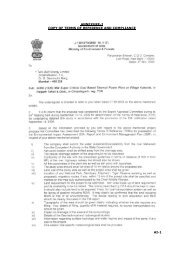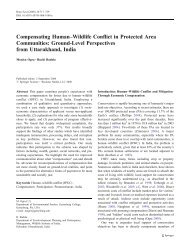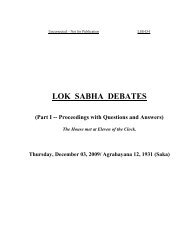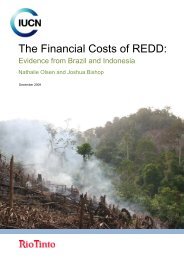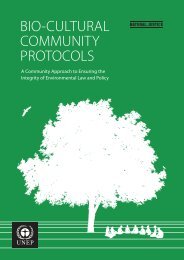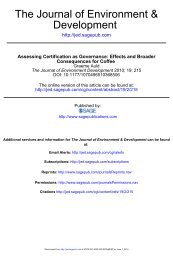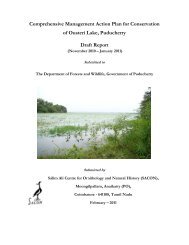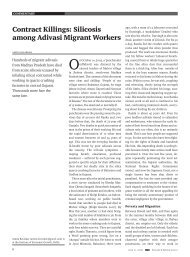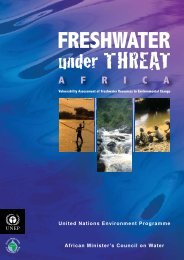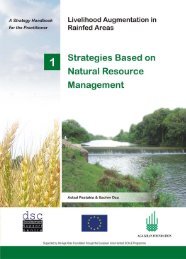Integrated River Basin Planning – Replicable ... - India Water Portal
Integrated River Basin Planning – Replicable ... - India Water Portal
Integrated River Basin Planning – Replicable ... - India Water Portal
You also want an ePaper? Increase the reach of your titles
YUMPU automatically turns print PDFs into web optimized ePapers that Google loves.
<strong>Integrated</strong> <strong>River</strong> <strong>Basin</strong> <strong>Planning</strong>: <strong>India</strong> and the EU share experience on policy and practice<br />
Annex<br />
A3.4 <strong>Water</strong> Framework Directive 2000/60/EC<br />
The overall purpose of the <strong>Water</strong> Framework Directive is to establish a framework<br />
for the protection of European inland surface waters, transitional waters, coastal<br />
waters and groundwater. The environmental objective of the WFD is to achieve<br />
‘good status’ for all groundwater and surface water by 2015 at the latest.<br />
“Good status” is a concept that on the one hand ensures protection of all water<br />
bodies in a holistic way, and on the other hand integrates quality objectives for<br />
specific bodies of water derived from other legislation, e.g. the Drinking <strong>Water</strong> and<br />
the Bathing <strong>Water</strong> Directives. For surface water it consists of a general requirement<br />
for ecological protection (“good ecological status”) and a general minimum chemical<br />
standard (“good chemical status”). Good ecological status is defined in terms of the<br />
quality of the biological community, the hydro-morphological characteristics and<br />
the chemical characteristics. The controls are specified as allowing only a slight<br />
departure from the biological community that would be expected in conditions of<br />
minimal anthropogenic impact, thus accounting for ecological variability between<br />
different waters. Good chemical status is defined in terms of compliance with all the<br />
quality standards established for chemical substances at the European level.<br />
For groundwater, the WFD takes a precautionary approach, and defines ‘good status’<br />
both in terms of chemical purity and of balance between abstractions and natural<br />
recharge. Direct discharges to groundwater are generally prohibited. To control<br />
pollution from indirect discharges, there is a requirement to monitor groundwater<br />
bodies in order to detect changes in chemical composition and reverse pollution<br />
trends. In addition, the Directive also deals with groundwater quantity. There is only<br />
a certain amount of recharge back into groundwater each year; of this recharge,<br />
some is needed to support connected ecosystems (whether they be surface water<br />
bodies or terrestrial systems such as wetlands).<br />
activities of each river basin<br />
• International coordination is also required for those river basins that cross<br />
international boundaries.<br />
Programme of Measures<br />
Central to each <strong>River</strong> <strong>Basin</strong> Management Plan is a Programme of Measures to<br />
ensure that all water achieves good ecological status. This requires, at least, the<br />
full implementation of all national and EU legislation on water and related issues.<br />
If this basic set of measures is not sufficient to reach the goal of good ecological<br />
status, then the programmes must be supplemented by additional measures, such<br />
as stricter controls on pollution from industry or agriculture or from urban waste<br />
sources. This may also require consideration of land use planning measures.<br />
Combined Approach<br />
Pollution control should take a combined approach. <strong>Water</strong> Quality Objectives (WQO)<br />
and Emission Limit Values (ELV) must be established, with the stricter approach<br />
applying in any given situation. WQOs and/or ELVs already set in EU legislation<br />
have to be taken into account, such as the IPPC Directive, the Urban Wastewater<br />
Treatment Directive and the Directive on Discharges of Dangerous Substances<br />
to <strong>Water</strong>. <strong>Water</strong> used for the abstraction of drinking water is subject to greater<br />
protection.<br />
The WFD addresses water quantity insofar as it is relevant to water quality. Any<br />
abstraction of surface water or groundwater, except minor abstractions, has to be<br />
subject to a permitting procedure.<br />
Monitoring<br />
The key requirements of the WFD related to its implementation are described below.<br />
<strong>River</strong> <strong>Basin</strong> Management<br />
The new approach to water management requires water to be managed at the<br />
river basin level rather than according to administrative, geographical or political<br />
boundaries. This enables assessment of all activities that may affect the water and<br />
its control by measures which may be specific to the conditions of the river basin.<br />
<strong>River</strong> <strong>Basin</strong> Management Plans must be drawn up for each river basin; however,<br />
large river basins may be sub-divided into smaller units. The adoption of suitable<br />
institutional structures to achieve river basin management is one of the major<br />
challenges for the implementation. Some options are described below.<br />
• Utilising existing regional structures, but organised and adapted to ensure<br />
co-ordination of functions related to the river basin<br />
The monitoring of all water in terms of quantity and quality, especially surface water<br />
and groundwater, is an essential feature of the WFD. This requires surveillance<br />
monitoring, operational monitoring, investigative monitoring and compliance<br />
monitoring. Data on monitoring must be made available to the public.<br />
<strong>Water</strong> Pricing and Cost Recovery<br />
The Directive requires member states to apply the principle of cost recovery for<br />
providing water services, including environmental and resource costs, based on<br />
economic analysis and in accordance with the polluter pays principle. Costs must<br />
therefore be considered for the consumer/user of water, whether domestic, industry<br />
or agriculture. These costs should include construction, financing and maintenance<br />
of such measures as drinking water treatment and supply, the collection, treatment<br />
and discharge of waste water and water used for irrigation purposes.<br />
• Appointing a central supervisory body with river basin-based subsidiary<br />
departments or institutions to organise and undertake day-to-day work in<br />
Public Consultation and Information<br />
the river basins<br />
An important aspect of the <strong>River</strong> <strong>Basin</strong> Management Plans is the need to involve<br />
• Appointing individual river basin institutions with direct control over the<br />
the public. The authorities must inform the public of the proposals contained in the<br />
plans and obtain the opinions of the public and relevant stakeholders such as local<br />
communities, industry, other water users, water utilities, and relevant government<br />
departments and institutions. The authorities must ensure public access to draft<br />
<strong>River</strong> <strong>Basin</strong> Management Plans, finalised <strong>River</strong> <strong>Basin</strong> Management Plans, results<br />
76 77



